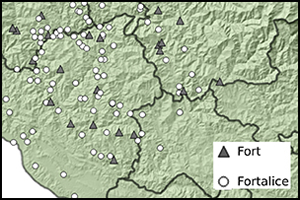Article contents
Networked medieval strongholds in Garhwal Himalaya, India
Published online by Cambridge University Press: 15 February 2021
Abstract

Hundreds of high-elevation medieval strongholds are dispersed throughout the Central Himalayan region of Garhwal Himalaya, India. Believed to have originated in the eleventh century AD, these sites are interwoven into local folklore, yet they have been subject to limited research. This article presents new survey data, along with computational and spatial analyses of 193 Garhwal strongholds, facilitating the assessment of more complex hypotheses—particularly visual-signalling theories—concerning the fortification phenomenon. The results strongly suggest the integration of Garhwal's strongholds as a coherent visual-signalling network. In turn, the method also holds great potential for the evaluation of putative visual-signalling networks in other archaeological contexts.
- Type
- Research Article
- Information
- Copyright
- Copyright © The Author(s), 2021. Published by Cambridge University Press on behalf of Antiquity Publications Ltd.
References
- 7
- Cited by


